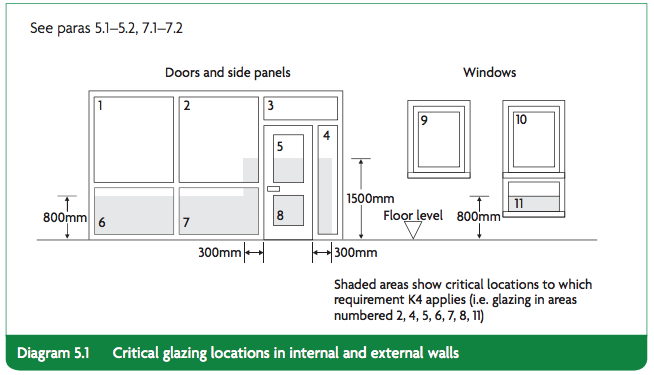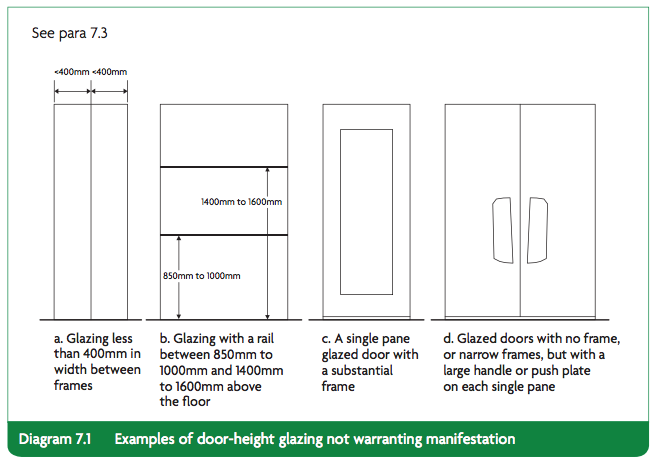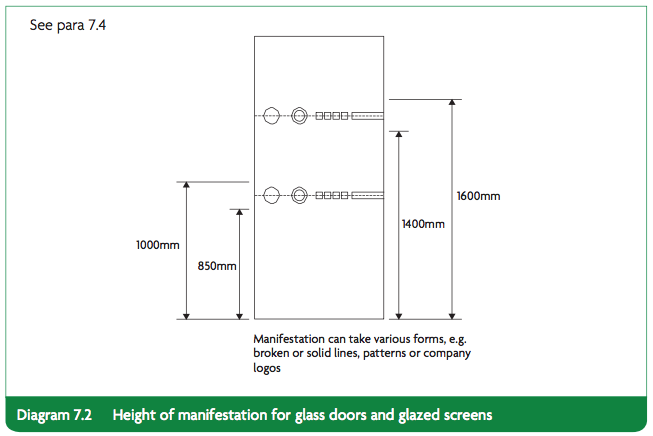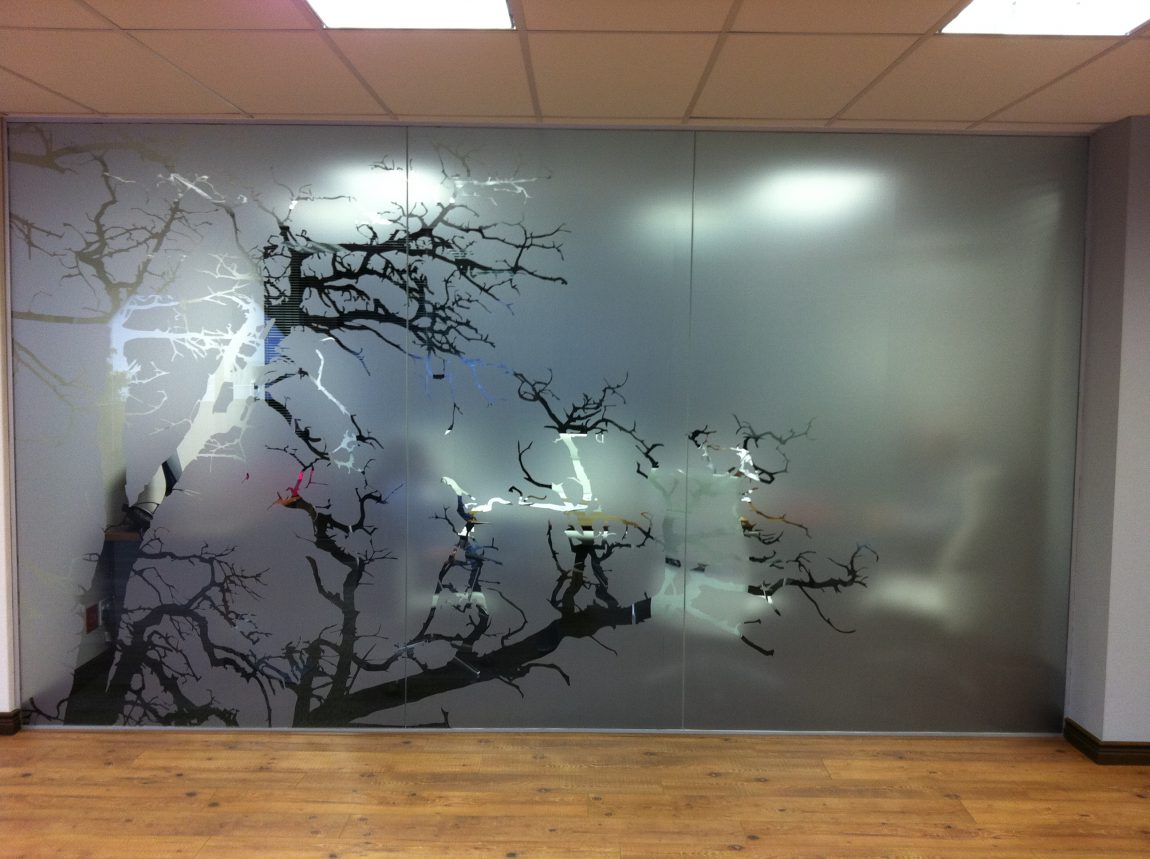Social Distancing Markings on Glass
If you would like to discuss social distancing signage and graphics on glass please get in touch via our contact form – our expert project managers are on hand to answer any of your questions.
In early 2018, a report emerged about employees at Apple injuring themselves by walking into glass walls. This might sound absurd (and frankly, it was a bit), but among the jokes about caffeinated millennials gawking at iPhones and absentmindedly walking into things, an important issue was brought to public attention: safety markings on glass.
For any large glass door, wall, or installation in a public place, there is a legal requirement to ensure the glazing is marked sufficiently to let people know it’s there, and prevent them from walking into it. These markings, known as ‘manifestations’, are adhered to the glass, and as is the case with many building safety requirements, the regulations for glass manifestations can be more than a little confusing initially.
For anyone working in facilities management, office and building design or environmental branding, however, understanding the scope of these regulations is vital. Moreover, it’s also worth noting that glass manifestations present more than just a safety opportunity…
Glass Manifestation Regulations
The rules and regulations for glass manifestations are set out in two official documents: Regulation 14 ‘Windows and transparent or translucent doors, gates and walls’ of the Workplace (Health, Safety and Welfare) Regulations 1992, and also in the HM Government Building Regulations, section K (‘protecting from falling, collision, and impact’).
Amongst a wealth of complicated jargon, there are a few key principles to take note of. The documents state that glass in critical locations must be built from safety glass, and clearly marked with manifestations of one one form or another, between specific heights.
This can raise a few questions, however:
What are ‘Critical locations’?
Glass manifestations don’t necessarily have to be adhered to every window, door, and pane of glass in a building.
Manifestations are there simply to ensure people don’t walk into the glazing (or worse, through it). As such, there are specifically defined ‘critical locations’ that do require safety markings.
This diagram is arguably a little confusing, but put simply, glazing installations that will require manifestations are:
- tall and/or large and wide
- could potentially pose a risk to the public if they aren’t clearly demarcated.
What type of glazing doesn’t require a manifestation?
Certain glass installations won’t require the use of glass manifestations, usually because their size, shape, or position means they don’t pose a significant risk to the public. This includes things such as windows, thin glass panels, and glass barriers built with rails below a specific height:
Where do glass manifestations need to be placed, and how big do they need to be?
When it comes to the actual manifestations themselves, size and positioning is very important. Regulations state specifically at which height glass safety markings should be placed, as they need to cover enough of the surface to ensure that the glazing is visible from various heights and from different angles.
Specifically, manifestations need to be placed between a height of 850mm and 1000mm on a glass pane, and again between 1400mm and 1600mm. The slightly thicker measurements for the higher manifestations is what has led to the ‘line of thick dots over line of thin dots’ design that’s frequently seen in public buildings, although there is no requirement for manifestations to involve specific patterns (more on that later).
It’s important to note that these are minimum requirements. While manifestations can take many forms, they need to cover and mark the spaces outlined in the diagram above to be legally recognised as compliant.
Do Glass Manifestations need to feature a specific design?
The short answer to this is no, but there are a few things to bear in mind. While there isn’t an official or designated design to utilise, when it comes to glass manifestations, the Building Regulations do specify that they must be:
‘contrasting visually with the background seen through the glass (both inside and out) in all lighting conditions.’
As for the design, they advise that it ‘takes the form of logo or sign at least 150mm high (repeated if on a glazed screen), or a decorative feature such as broken lines or continuous bands, at least 50mm high’.
This leaves quite a bit of freedom and scope when it comes to the design of a manifestation, and it’s actually possible to kill two birds with one stone (just don’t throw it near the glass). As the rules regarding height in mm and the location of the manifestation are very specific, it can be challenging to ensure the measurements of your designs are precisely correct.
Instead, it can be far more effective and convenient to opt for a larger, slightly more elaborate design for a glass manifestation. Not only will something like this meet the necessary regulations, it will also open up all kinds of avenues when it comes to interior branding.
Printed glass manifestations
Advances in technology mean that printers such as PressOn can produce glass manifestations with almost any design, and on a variety of different materials. These can contribute significantly to the overall aesthetic of an aligned or branded interior environment – and there are any number of ways in which printed glass manifestations benefit a workspace:
They add privacy
While open-plan offices have become something of a cliche for the startup workspace, it’s still common to see meeting rooms or sections of a working environment that have been dedicated to quiet work. These segmented spaces can benefit hugely from privacy, and glass manifestations allow brands to demarcate these sections of their offices for individual or private work.
They can act as a brand endorsement
Even the Building Regulations guidelines acknowledge the potential of manifestations as a brand endorsement, suggesting the use of a company logo, and the opportunity afforded by glass manifestations to galvanise an aligned interior space is significant. Whether this involves the use of a subtle motif from a company logo or slogan, a coloured design in line with brand guidelines, or something as overt as a large printed photograph, the sky really is the limit.
They can motivate the workforce
Studies have found that in general, employees working in well-designed and carefully planned workplaces perform better than those working in uninspiring offices. While the trend towards ‘funky’ offices replete with ball-pits might cause eyes to roll, a well-thought out interior design can have a tangible impact on how staff perform. When you consider that glass manifestations are a safety regulation requirement anyway, it makes perfect sense to use them to this end.





